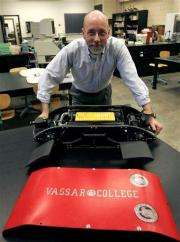Robots with fins, tails demonstrate evolution

(AP) -- Robots wag their tail fins and bob along like bathtub toys in a pool at a Vassar College lab. Their actions are dictated by microprocessors housed in round plastic containers, the sort you'd store soup in.
It hardly looks like it, but the two swimming robots were set loose in the little pool to study evolution, acting out predator-prey encounters from roughly 540 million years ago.
The prey robot, dubbed Preyro, can simulate evolution.
This is not like robot evolution in the "Terminator" movie sense of machines turning on their human masters. Instead, Vassar biology and cognitive science professor John Long and his students can make changes to the tail of Preyro to see which designs help it avoid the predator robot.
"We're applying selection," Long explains, "just like natural selection."
Long is among a small group of researchers worldwide studying biology and evolution with the help of robots that can do things like shimmy through water or slither up shores. Long's robots, for instance, test theories on the development of stiffer backbones. The researchers believe the machines will catch on as technological advances allow robots to mimic animals far better than before.
Microprocessors are now tinier and more sophisticated. Building materials are more pliable. The same technology driving the use of electronic prosthetic limbs and vacuuming robots also is giving scientists a sophisticated tool to study biology.
"In the past, if you think about it, robots wouldn't work because we could only make these big metal things with rotating joints that were really stiff ... and that's not how nature is," said Robert J. Full, professor of integrative biology at the University of California, Berkeley.
Full's lab at Berkeley has built robots that can creep like cockroaches or climb like geckos. In Switzerland, researchers built a bright yellow salamander robot a few years ago that can swim and walk to investigate vertebrates' transition from water to land. They posted a Web video of the robot squirming out of Lake Geneva.
At Harvard University, George Lauder, professor of organismic and evolutionary biology, studies fish locomotion with the aid of robotic fins. He says scientists are not trying to build spitting images of animals, but rather to mimic certain characteristics - a fin or a spinal column - to study how they work. Scientists then alter that characteristic to see how it affects performance.
The small amount of robot research performed so far has yet to dramatically alter evolutionary studies, but it has helped researchers evolve their understanding of some animals.
Consider Madeleine the swimming robot. Madeleine is roughly the size and shape of a big bed pillow with four flippers sticking from its sides, but it was used to study a 45-ton marine reptile that patrolled the seas in the Jurassic Period.
Fossil records show that the massive pliosaur, dubbed Predator X, had two sets of largely symmetrical flippers, indicating the animal used all four to swim. Long said that sets Predator X apart from modern animals like otters, sea lions and turtles, which tend to use one set of flippers for propulsion and the other for steering.
Researchers studying Predator X asked Long to investigate why the creature used all four flippers for swimming. Madeleine was programmed to swim with two flippers, then all four. The robot demonstrated that using four flippers to swim could be a bad proposition, energy-wise. But they do provide a sort of turbo-boost for quick accelerations - handy for catching dinner.
"The otter and the pliosaur both swim the same speed," Long said, "but, man, that pliosaur can really take off."
The Preyro robot experiment allows Long to take his evolutionary studies a step further.
By setting up Preyro in a pool with another autonomous robot - a predator named Tadiator - Long and his students simulated an evolutionary scenario. They wanted to examine qualities that would help vertebrate sea creatures of the Cambrian Period forage for food without becoming lunch for predators. Specifically, they wanted to test the hypothesis that the ancient creatures' need to scoot away fast from predators drove the evolution of stiffer tails.
Students could stiffen Preyro's backbone by fitting plastic rings (representing vertebrae) over a jelly-like column running down the tail designed to simulate the biological structures of ancient sea creatures. More rings made for a stiffer tail.
They found that changing the size of Preyro's tail fin had no effect, but that backbones stiffened with vertebrae helped Preyro swim away from danger faster. Seven vertebra worked the best; any more made the tail too stiff. They concluded that the evolution of multiple vertebrae could have been influenced by the need to avoid predators while foraging.
Robot builders like Long still use computer simulations to complement their work. But Long says swimming robots like Madeleine and Preyro have advantages over computer simulations because it is extremely difficult to simulate the interaction between a flexible solid - like an animal's tail - and a liquid.
"The thing about robots is, robots can't violate the laws of physics," he said. "A computer program can."
Lauder said there's no substitute for building a device that can replicate the minutely complex features of an animal. He expects the rise of robots in biological research to accelerate as more advances are made.
"The next 20 years are going to be amazing, I think," Lauder said.
---
On the Net:
http://faculty.vassar.edu/jolong/jolong.html
©2009 The Associated Press. All rights reserved. This material may not be published, broadcast, rewritten or redistributed.

















